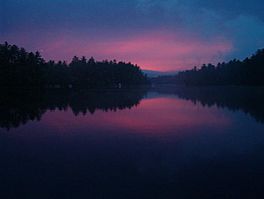Balch Pond facts for kids
Quick facts for kids Balch Pond |
|
|---|---|
| Stump Pond | |
 |
|
| Location | Carroll County, New Hampshire; York County, Maine |
| Coordinates | 43°36′58″N 70°58′39″W / 43.61611°N 70.97750°W |
| Type | Lake |
| Primary outflows | Little Ossipee River |
| Catchment area | 14.3 square miles (37 km2) |
| Basin countries | United States |
| Max. length | 3.7 mi (6.0 km) |
| Max. width | 1.7 mi (2.7 km) |
| Surface area | 577 acres (2.34 km2) |
| Average depth | 10 ft (3.0 m) |
| Max. depth | 46 ft (14 m) |
| Water volume | 6,578 acre⋅ft (8,114,000 m3) |
| Residence time | 136 days |
| Shore length1 | 10.1 miles (16.3 km) |
| Surface elevation | 558 ft (170 m) |
| Settlements | Wakefield, New Hampshire; Acton and Newfield, Maine |
| 1 Shore length is not a well-defined measure. | |
Balch Pond is a beautiful body of water that covers about 577 acres. It sits right on the border between the states of New Hampshire and Maine in the United States. A part of the lake in New Hampshire is also known as Stump Pond.
Contents
What is Balch Pond?
Balch Pond is a freshwater lake that spans across two states. It's a popular spot for outdoor activities. The lake is quite large, stretching about 3.7 miles long and 1.7 miles wide. Its deepest point is about 46 feet.
Where is Balch Pond located?
This interesting pond is located in two different states at once! It's found in Carroll County, New Hampshire, and York County, Maine. The towns that share the lake are Wakefield, New Hampshire, and Acton and Newfield, Maine.
What kind of fish live in Balch Pond?
Balch Pond is known as a "warmwater fishery." This means its waters are warm enough for certain types of fish to thrive. You can find many different kinds of fish here. Some common ones include largemouth bass, chain pickerel, and brown bullhead. Other fish you might spot are black crappie, yellow perch, and different types of sunfish.
How does water flow from Balch Pond?
Water from Balch Pond flows out from its eastern side. This water then enters the Little Ossipee River. The Little Ossipee River is a smaller river that eventually joins the larger Saco River. This shows how water bodies are all connected!




